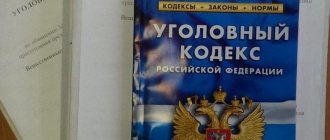Practice shows that courts willingly satisfy claims related to lost profits if the position of entrepreneurs is justified by specific facts and supported by strong evidence.
In this article we will consider the following questions:
- What is lost profit
- Frequent situations related to lost profits
- How to prove lost profits
- Claim to the counterparty and statement of claim to the court
- Judicial practice and conditions for satisfying a claim
- Calculation of lost profits
- What cannot be recovered as lost profits
What is lost profit
According to Part 2 of Art. 15 of the Civil Code of the Russian Federation, lost profits are a type of loss. In particular, these are lost income that would have been received under normal conditions if not for the violation of the law.
Executive Director and Chief of Staff of the Ryazan Regional Branch of the Russian Bar Association Lyubov Larina notes that in judicial practice, lost profits are understood more broadly - this is lost income by which a person’s property mass would have increased if his rights had not been violated (clause 14 of the Resolution of the Plenum of the Supreme Court of the Russian Federation dated June 23, 2015 No. 25).
“Entrepreneurship is always associated with financial risks, but if the profit was lost due to the fault of third parties, the legislator gives the entrepreneur a chance to compensate for lost profits,” says Lyubov Larina.
The expert notes that it is important not to confuse lost profits and real damage, which refers to the costs of an entrepreneur to restore a violated right, lost or damaged property.
According to Evgeniy Sokolov, head of the “Arbitration Dispute Resolution” legal department, in Russia damages in the form of lost profits are not recovered so often. The reasons are clear - the alleged amount is difficult to prove, and it is equally difficult to understand that it was the behavior of the offender that led to the losses of the victim. Despite this, the number of claims satisfied by the courts is gradually growing.
Document overview
Despite the introduction of a new edition, the unified MTPL methodology retains the basic principles of calculation that have been in effect since 2014. The document describes in detail the following aspects of calculating the cost of restoration repairs in relation to a car damaged in an accident. These include:
- the procedure for determining the nature of damage received by the vehicle;
- rules for calculating and grouping expenses by cost items - materials, spare parts, workers' salaries, etc.;
- the procedure for determining the degree of wear of components and components that must be replaced;
- rules for calculating the value of usable remains, which can be used even after the complete loss of the car;
- the procedure for compiling, approving and publishing directories containing the average costs of spare parts, consumables and hours of work as part of restoration repairs;
- list of requirements for recording vehicle damage.
The unified calculation methodology for compulsory motor liability insurance is used by both insurance companies and specialized expert organizations or private experts, including judicial ones. Proper use of the rules approved by the regulator allows you to speed up the resolution of disputes both in court and pre-trial.
Frequent situations related to lost profits
Lawyer Lyubov Larina gives a typical example of the renovation of an office building.
“The owner of an office building entered into an agreement with a contractor to renovate the building for one month. He also made additional agreements with tenants that they would not pay rent for that month. During the repairs, the network cable was damaged, the owner suffered additional losses, and the repairs dragged on for another month.”
What will be the actions of the building owner in connection with the events?
- Firstly, he may demand compensation for the costs of repairing the damaged cable - these will be losses in the form of real damage.
- Secondly, the owner has the right to demand compensation for lost profits, which consists of rental payments for the month during which the repairs were delayed.
The possibility of recovering lost profits is enshrined in some legislative acts:
- in Art. 18 Federal Law dated March 26, 2003 No. 35-FZ;
- in Art. 77 Federal Law of January 10, 2002 No. 7-FZ;
- in Art. 38 of the Federal Law of March 13, 2006 No. 38-FZ.
The expert shares the most common situations when a company may not receive income.
The product cannot be used for its intended purpose
Details are in the Appeal Ruling of the Voronezh Regional Court dated February 28, 2017 in case No. 33-1488/2017.
Situation
The citizen filed a lawsuit against the car dealership demanding replacement of goods of inadequate quality and recovery of lost profits. Previously, he bought a truck and transferred it under a lease agreement to an individual entrepreneur for cargo transportation. During the warranty period, the engine caught fire and the truck was almost completely destroyed. Experts determined that it caught fire due to a technical malfunction.
The truck owner calculated the amount of lost profits based on the amount of the rent and the period during which he could not receive it: 50,000 rubles. × 9 months = 450,000 rub.
The claims were satisfied in full.
Obligations under the lease agreement have not been fulfilled
Details are in the Appeal Ruling of the Moscow Regional Court in case No. 33-18925/2015.
Situation
The owner of the non-residential premises and the legal entity entered into a lease agreement. The owner was supposed to reconstruct the building before it was leased, but was unable to do this because part of the premises was occupied by a previous tenant whose lease had expired.
The owner did not intend to renew or enter into a new contract and continued to use the premises despite the owner's notifications. The owner filed a claim to recover lost profits from the unscrupulous tenant in the amount of rent for the disputed premises for the period of delay.
Authorities and officials act illegally
The Federal Customs Service of Russia issued an order (later declared illegal) limiting the places where ferrous scrap metals exported from the Russian Federation can be declared. As a result, the export of these goods from the ports of Primorsky Krai was prohibited.
A legal entity with a license to export only within the Primorsky Territory was unable to fulfill contracts and suffered losses. The exporting company's claim against the Federal Customs Service for actual damages and lost profits was satisfied.
Example of a difficult situation
Evgeniy Sokolov from the legal department cites as an example a case from practice when the appellate court, based on the results of the examination, overturned the first court decision and partially satisfied the stated requirements.
Situation
The contractor and the customer entered into three contract agreements for the development of design documentation from December 2014 to May 2015. The contractor handed over the completed work to the customer in June-September 2015, but the customer refused to accept the work due to violation of deadlines and some shortcomings in the work.
The contractor tried to correct some of the deficiencies, but in September 2015 the customer demanded to suspend the work under all contracts and refused to accept the work, citing lack of funding.
In 2016-2018, the contractor several times asked the customer to renew the contracts or terminate them by agreement of the parties and went to court, indicating that the customer had violated his obligations and asking to recover from the customer the cost of the work actually performed, minus the cost of correcting the defects.
The court of first instance refused to satisfy the demands and pointed out that the plaintiff did not prove the conditions for recovery. Based on the results of the forensic examination, the appellate court overturned the first court decision and partially satisfied the stated demands: it terminated the work contracts and recovered damages in the amount of 82% of the declared ones.
The court considered that a long suspension of contracts and work for more than 3.5 years introduces uncertainty into the relations of the parties. The contractor could not continue work according to Sec. 37 of the Civil Code of the Russian Federation, which does not imply that the contractor performs work against the will of the customer, which means the contractor could not demand payment for such work under the terms of the contract.
Analyze your counterparty's arbitration cases to better understand their market behavior style
The contracts were terminated, damages were recovered - the cost of work under construction contracts with the deduction of the cost of independent work to eliminate deficiencies in the design documentation (Resolution 9 of the AAS dated 04/22/2019 in case No. A40-135847/2018).
How is the payment amount determined?
The amount of compensation for damage includes the cost of spare parts at the time of the accident, payment for necessary repairs and the cost of auxiliary materials used. When evaluating spare parts, the time and percentage of their wear are taken into account. Work to improve the quality of the damaged vehicle is not paid for.
Repair work includes: restoration (painting, diagnostics and adjustment), as well as final inspection work. Car owners should remember that repair after an accident means returning the vehicle to its original state before the accident, and not a complete replacement with a new one.
The participant in the accident has the right to demand a certified copy of the expert report on the damage and calculate the cost of repairs from an independent specialist. If there is a suspicion that the compensation amount has been understated, the insured may conduct an independent expert assessment. You can also involve an expert to confirm the absence of hidden damage if an examination has not been carried out. The result of the check should be provided to the insurer to clarify the calculation of damage payments after an accident.
The total cost of repair consists of the sum of the cost of repair work, the cost of purchasing additional materials and new spare parts to replace damaged ones. The approximate calculation formula is:
OSrr = SSrr + DP + NC
How to prove lost profits
Kirill Afonin, founder of the legal telegram digest “Lawyer's Secret,” advises to be procedurally active and in any case offer your own version of the calculation.
Use all legal possibilities to prove lost profits (Article 65 of the Arbitration Procedure Code of the Russian Federation, Article 56 of the Code of Civil Procedure of the Russian Federation). For example, apply to the court to order a forensic examination to determine the most likely amount of losses (Article 82 of the Arbitration Procedure Code of the Russian Federation, Article 79 of the Code of Civil Procedure of the Russian Federation).
“In my opinion, it is more realistic to prove lost profits today than it was 5-6 years ago, thanks to the Resolution of the Plenum of the Supreme Court of the Russian Federation dated June 23, 2015 No. 25,” Kirill Afonin is sure.
In fact, in court you will have to prove three circumstances, warns lawyer Lyubov Larina:
- that no income was received;
- that the rights of the creditor were violated;
- that illegal behavior prevented you from earning income.
If at least one circumstance is not proven, the claim will not be satisfied.
What needs to be proven
Based on current judicial practice, when recovering lost profits, it is important to prove that the possibility of receiving income actually existed.
To do this, you need to document the completion of specific actions and preparations aimed at extracting income that was not received in connection with the debtor’s violation.
So you should:
- Document the possibility and inevitability of receiving income, that is, the reality of receiving a profit, taking into account the expected expenses from the property that was damaged (Resolution of the Presidium of the Supreme Arbitration Court of the Russian Federation dated May 21, 2013 No. 16674/12, Determination of the Supreme Court of the Russian Federation dated January 29, 2015 No. 302-ES14-735 ).
- Confirm the legal ownership of this property by the person entitled to receive income.
- Establish the guilt of the causer of damage and the causal connection between the wrongfulness of the causer of harm and the resulting losses.
- Prove that the violation was the only obstacle that did not allow the legal owner of the property to receive income (Resolution of the Presidium of the Supreme Arbitration Court of the Russian Federation dated May 21, 2013 No. 16674/12).
According to Kirill Afonin, the following will help prove lost profits:
- Agreements with third parties and related correspondence.
For example, if the tenant did not return the property to you after the lease agreement was terminated, you can present a preliminary lease agreement concluded with a third party that was terminated because of this. This will help confirm that you suffered losses in the form of lost profits.As an example, in the Resolution of the Presidium of the Supreme Arbitration Court of the Russian Federation dated May 21, 2013 No. 16674/12, the court took into account that after the return of the property, the lessor entered into a lease agreement with a person who was a party to the terminated preliminary agreement.
- Bank documents.
Together with the agreement on opening a current account, such documents can confirm that, for example, as a result of non-receipt of funds into the account, interest was accrued on the account balance in a smaller amount.You can also “arm yourself” with the testimony of witnesses.
Evidence must confirm precisely the actions aimed at obtaining income that was not received as a result of a violation of the obligation.
“The court may not recognize information about employees, rental premises and permission to perform work as evidence of preparations to receive income under a specific contract,” warns Kirill Afonin. “All this is necessary to carry out business activities and achieve the goals of creating an organization.”
Causal link between breach of obligation and losses
When establishing a connection, it is necessary to take into account what consequences such a violation could lead to under normal conditions of civil circulation.
“If the occurrence of losses, the compensation of which the creditor demands, is a common consequence of the debtor’s violation of the obligation, then the existence of a causal connection between the violation and the losses proven by the creditor is assumed,” notes Kirill Afonin.
If the debtor refutes the creditor's arguments regarding the causal connection between his behavior and the creditor's losses, he may provide evidence of the existence of another cause of these losses.
Causal link between breach of obligation and losses
When establishing a connection, it is necessary to take into account what consequences such a violation could lead to under normal conditions of civil circulation.
“If the occurrence of losses, the compensation of which the creditor demands, is a common consequence of the debtor’s violation of the obligation, then the existence of a causal connection between the violation and the losses proven by the creditor is assumed,” notes Kirill Afonin.
If the debtor refutes the creditor's arguments regarding the causal connection between his behavior and the creditor's losses, he may provide evidence of the existence of another cause of these losses.
What factors can influence the amount of damage?
An expert report on the inspection of a vehicle after an accident is the main document by which the amount of damage is calculated. As hidden damage is discovered or additional examinations are carried out, information may be added to it. Information for calculating repair costs is taken from this act.
Important criteria for assessing the condition of a car:
- vehicle brand;
- the year of its production and registration;
- equipment of the car at the time of purchase;
- the city where the car was registered and where the accident occurred;
- what condition was the car in before the accident;
- What is the condition of the parts requiring replacement?
The insurance company uses average cost indicators to calculate the cost of repairs:
- repair work;
- materials for work;
- spare parts for replacement.
The last indicator is taken from the Unified Electronic Directory of Prices for Auto Parts, compiled by RSA. It is posted on the Internet, in the public domain. The directory is periodically updated. Essentially, this is a simple calculator. To calculate the price, you need to indicate the date of the accident, the make of the car, the economic zone number and the spare part number.
Indicators that reduce the amount of compensation:
- wear of damaged spare parts (expressed as a percentage);
- year of vehicle manufacture, operating time;
- distance traveled in kilometers.
If repairs are impossible or their cost will be more than the cost of a new car, the insurance company is obliged to pay compensation in an amount sufficient to purchase a new car. The calculation method is also used here. The cost of whole spare parts is subtracted from the estimated cost of a new car. It is assumed that the owner will be able to implement them. The coefficients for calculating their cost are also determined by EMRU.
In addition to compensation for property damage after an accident, compensation can be made for harm to life and health caused by the accident. The government approved the rules for calculating insurance amounts and determined the standards for calculating the amount of compensation in Resolution No. 1164 of November 15, 2012.
Claim to the counterparty and statement of claim to the court
The counterparty must submit a claim in which:
- the obligation he violated is described;
- the calculation of lost profits is presented.
If the counterparty does not satisfy the claim, you should file a claim in court. Here, for example, is a sample statement of claim for recovery from the tenant of losses caused by the loss of a rental item.
“The unlawful behavior of the defendant can be expressed, for example, in a unilateral refusal without explanation to fulfill its obligations under the concluded agreement,” says Kirill Afonin. “The causal connection between the fact of causing harm (losses) and the action (inaction) of the harm causer must be direct.”
It is important that the statement of claim contains a substantiation of the stated positions, and that the plaintiff’s arguments are supported by evidence - it is the plaintiff who bears the burden of proof.
Judicial practice and conditions for satisfying a claim
Proof of the totality of the above facts leads to the satisfaction of the claim. If at least one of the elements of the offense is not proven, the courts often refuse to satisfy the claim.
This is confirmed by:
- Decision of the Arbitration Court of the Moscow Region dated December 30, 2016 in case No. A41-57422/16;
- Decision of the Arbitration Court of the Samara Region dated December 30, 2016 in case No. A55-22074/2016;
- Decision of the Arbitration Court of the Khanty-Mansi Autonomous Okrug - Ugra dated December 30, 2016 in case No. A75-8314/2014;
- Decision of the Arbitration Court of the Moscow Region dated June 27, 2016 in case No. A40-171174/2015.
“The debtor has the right to present his objections regarding the amount of losses caused to the creditor and, for example, present to the court evidence that the creditor intentionally or negligently contributed to an increase in the amount of losses or did not take reasonable measures to reduce them,” says Kirill Afonin.
When the court refuses to satisfy the requirements
Most often, a claim is denied when the plaintiff cannot provide evidence that he suffered losses due to the defendant’s unlawful behavior.
When determining lost profits, the following are taken into account:
- measures taken by the creditor to obtain it;
- preparations made for this purpose;
- facts that you were actually preparing to receive income (have legal significance).
Lawyer Lyubov Larina gives an example when the court refuses (Appeal ruling of the Moscow City Court dated March 20, 2015 in case No. 33-9040).
Situation
The head and founder of the legal entity was subject to illegal criminal prosecution, during which he was unable to engage in business and lost orders and clients.
After the termination of the criminal prosecution, he filed a lawsuit against the Ministry of Finance, demanding to recover lost profits in proportion to his share in the authorized capital of the organization during the period of criminal prosecution.
The court rejected the claim, pointing out that the plaintiff is not the only founder of the organization. Nor did he prove that he could not have been replaced during his absence.
Examples of satisfying claims for recovery of lost profits
But there is also positive judicial practice. Kirill Afonin draws attention to some examples.
- Resolution of the Arbitration Court of the Volga District of February 21, 2018 No. F06-18601/2017 in case No. A06-5477/2016 The courts of the Volga District satisfied the claim for recovery of lost profits, since it was confirmed that there was a cause-and-effect relationship between the defendant’s refusal to fulfill contractual obligations and the occurrence the plaintiff suffered losses, the amount of which was proven.
- Resolution of the Presidium of the Rostov Regional Court dated January 25, 2018 No. 44G-6/2018 The court sent the case for a new trial, pointing out the need for an objective assessment of the income that the creditor could receive, taking into account reasonable expenses under normal conditions of civil circulation.
- Resolution of the Arbitration Court of the North Caucasus District dated December 27, 2016 No. F08-9566/2016 in case No. A32-21933/2015 The dispute was referred for a new trial only because the lost profits were mistakenly identified with the amount of remuneration due for the disputed period. This case only points out the need to exclude those costs and expenses that would have been incurred in the actual provision of services.
Calculation of lost profits
The universal formula for calculating lost profits is as follows: Lost profits = Potential income - Potential expenses
But experts recommend, in addition to calculating the income that you did not receive, to calculate the costs that you would have incurred if you received the income:
- tax payments;
- salary;
- Payment of utility services;
- payments to counterparties.
“For example, if no rental income was received, utility bills and property taxes must be deducted from it. All amounts are deducted in proportion to the period during which no income was received,” notes Lyubov Larina.
If the violator received income due to the violation, you can demand compensation from him for lost profits in an amount no less than such income (Article 15 of the Civil Code of the Russian Federation).
Receive the most important information about the counterparty in one window and an express report
Sometimes it is useful to seek help from an expert when making calculations. Especially if you can’t do it yourself. According to Lyubov Larina, the expert uses a universal scheme, but carries out a fairly large number of calculations for each of the indicators of this formula and explains on the basis of what facts he draws his conclusions.
Keep in mind that the costs spent on a specialist can be recovered in court along with the satisfaction of the claim.
Popular calculation methods
Retrospective assessment
The amount of potential income and lost profits for a certain period of time is calculated based on the previous similar period. This will require accounting documents confirming profitability.
Economic modeling
If it is not possible to use historical financial indicators, you can build an economic model taking into account demand, competition and other circumstances that may affect revenue generation.
How to calculate lost profits taking into account time
Lawyer Lyubov Larina draws attention to the fact that lost profits are calculated approximately.
“At the same time, the calculation must be as close as possible to reality and documented. This can be proven by contracts with counterparties, business correspondence, and expert opinions.”
Calculation of the amount of lost profits in contractual relations can be based on the Temporary Methodology for determining the amount of damage (losses) caused by violations of business contracts (approved by the USSR State Arbitration Court of December 28, 1990).
Situation 1
A retail store is suing for damages over faulty repairs that prevented it from selling merchandise as usual.
Lost profits can be calculated based on the plaintiff's financial statements of profit for a similar period of time, either before the defendant's breach of obligation or after the violation ceased.
Situation 2
A framework agreement was concluded between the pharmaceutical company and the distributor for a period of 5 years, according to which the distributor invested in the development and production of the drug, and the pharmaceutical company had to supply the drug according to the distributor’s requests for 5 years. On the part of the distributor, the obligations were fulfilled properly, but the pharmaceutical company did not deliver the drug.
In the distributor's claims, the calculation of lost profits was based on a bonus agreement entered into between the plaintiff and the defendant. According to its terms, in order to increase sales volumes, the defendant agreed to pay the plaintiff bonuses in the amount of 16.5% of the amount of the concluded agreement. Thus, the plaintiff justified the amount of lost profits by the fact that if his right had not been violated, he could have received a profit in the amount of at least 16.5% of the contract amount (Determination of the Supreme Court of the Russian Federation dated December 7, 2015 in case No. 305-ES15 -4533).
Vehicle examination after an accident
The result of the initial examination will be a report on the condition of the car after the accident. It indicates information regarding the place and time of the expert assessment. They also list the participants in the road accident present during the examination, clarify information about the general condition of the vehicle, the presence of defects not related to the accident, and the presence/absence of hidden damage. Photo and video evidence confirming the facts of the inspection may be attached to the report. A second examination may be required if hidden damage is detected.
Currently, priority is given to remedial repairs rather than monetary payments. Therefore, before calculating the cost of damage from an accident, experts first of all evaluate:
- how deformed the surface is;
- the degree of damage to spare parts at the point of impact;
- percentage of damage to components and assemblies requiring their complete replacement.
Based on the study, the expert makes a decision on the possibility of restorative repairs or complete replacement of individual parts of the vehicle. Using the methodology, he calculates the cost of repair work and the amount of monetary compensation for damage after a traffic accident. The report is filled out within 3 to 10 days after inspection of the car.
The scope of repair work is contained in the fifth chapter of the methodology. It is large and quite confusing, but a must-read for all car owners. To determine the feasibility of repairs, the expert is guided by the sixth chapter of the methodology.
What cannot be recovered as lost profits
Lyubov Larina draws attention to the fact that in the legislation one can find a direct prohibition on the recovery of lost profits. For example, it is impossible for an employer to recover lost profits from an employee (Article 238 of the Labor Code of the Russian Federation). The agreement may limit the possibility of recovering lost profits - in whole or in part).
Kirill Afonin notes other features:
- In accordance with paragraph 1 of Art. 547 of the Civil Code of the Russian Federation, the party that violated the obligation under the energy supply contract is obliged to compensate only for the actual damage caused.
- Lost profits due to clause 2 of Art. 777 of the Civil Code of the Russian Federation within the framework of a contract for the performance of research, development and technological work is subject to compensation only in cases expressly provided for by the contract.
- Under agreements on the alienation of the exclusive right to a work, as well as copyright and licensing agreements, in the event of failure to fulfill the contract, the author compensates the customer only for actual damage by virtue of Art. 1290 Civil Code of the Russian Federation.
Full or partial recovery of damages
You can recover material losses in full or in part. Recovery options depend on the specific circumstances.
Full recovery
Withholding the full amount of material losses is legal in cases where the following employees are at fault:
- Head of the company.
- Chief accountant or deputy manager if an agreement on full financial responsibility has been concluded with employees.
- Damage was caused by any employee with whom there is a liability agreement. The same employee is given valuable property on the basis of documents. For example, this is a cashier or storekeeper.
- An employee who was given valuable property on a one-time basis, if papers were drawn up at the same time. For example, an employee received money on account.
Full recovery is possible in the following circumstances:
- The employee caused damage while under the influence of alcoholic beverages.
- The damage was not caused during the performance of work duties. For example, a taxi driver used a car for his personal needs, and in the process crashed the car.
- Criminal intent was detected (that is, the damage was caused deliberately).
- An employee responsible for the security of commercial information disclosed confidential information.
The employer can receive full compensation even if the employee was convicted in connection with causing damage.
Partial recovery
Partial compensation involves withholding funds in the amount of the average monthly salary. It is relevant in cases where it is impossible to apply the provision of full liability. Payments are not made at once, since more than 20% cannot be withheld from one employee’s salary.
IMPORTANT! The average monthly salary is not the employee’s income for the current month. It must be calculated by dividing the total annual salary by the number of months.









